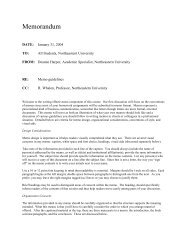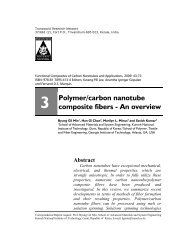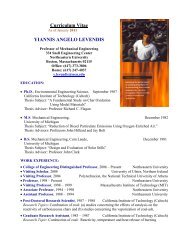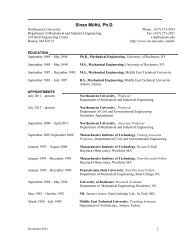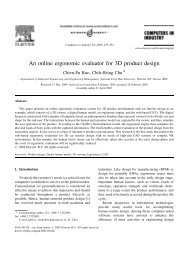You also want an ePaper? Increase the reach of your titles
YUMPU automatically turns print PDFs into web optimized ePapers that Google loves.
Table 2<br />
Headed steel anchor test configurations.<br />
Reference hef /d #<br />
Tests<br />
Viest (1956) [7]<br />
Shoup <strong>and</strong> Singleton (1963) [40]<br />
Chapman <strong>and</strong> Balakrishnan<br />
(1964) [41]<br />
Buttry (1965) [22]<br />
Chinn (1965) [9]<br />
Mainstone <strong>and</strong> Menzies (1967)<br />
[12]<br />
L. Pallarés, J.F. <strong>Hajjar</strong> / Journal of Constructional Steel Research 66 (2010) 198–212 201<br />
2.47, 2.55, 3.23, 3.22, 4.53,<br />
4.67, 4.77, 5.50, 7.00<br />
8.00, 6.30, 5.20, 6.67, 9.33,<br />
9.65<br />
12 1<br />
Type Type of test Type of concrete Range of f ′<br />
c ksi (MPa)<br />
4 studs (2 per side) Normal: 12 tests 3.19–4.39<br />
8 studs (4 per side) Lightweight: 0 tests (22.0–30.2)<br />
9 2 8 studs (4 per side)<br />
2, 3.29, 4.67, 7.29 9 1 4 studs (2 per side)<br />
2.00, 3.33, 3.50, 4.67, 5.38,<br />
5.90, 7.38<br />
3.33, 3.38, 3.41, 4.00, 4.67,<br />
5.38, 4.67<br />
22 1 4 studs (2 per side)<br />
10 1 4 studs (2 per side)<br />
4.67 11 1 4 studs (2 per side)<br />
Davies (1967) [11] 4.67 19<br />
Steele (1967) [10] 3.50 18 1 4 studs (2 per side)<br />
Dallam (1968) [24] 4.00, 4.67, 5.90, 7.38 17 1 4 studs (2 per side)<br />
Baldwin (1970) [25] 3.50, 4.00, 4.67, 5.90, 7.38 26 1 4 studs (2 per side)<br />
Menzies (1971) [42] 4.67 6 1 4 studs (2 per side)<br />
Hawkins (1971) [44]<br />
2.00, 2.33, 2.86, 3.00, 3.51,<br />
4.00, 4.67<br />
22 2<br />
1, 2,<br />
3<br />
Ollgaard et al. (1971) [15] 3.50, 4.21 48 1, 2<br />
Klingner <strong>and</strong> Mendonca (1982)<br />
[45]<br />
Hawkins <strong>and</strong> Mitchell (1984)<br />
[34]<br />
11 8 5 ‘‘In the field’’<br />
3.33 2 5 ‘‘In the field’’<br />
Jayas <strong>and</strong> Hosain (1989) [26] 4.30 1 3 12 studs (6 per side)<br />
Zhao (1993) [46] 2.27, 2.96, 4.09 18 5 ‘‘In the field’’<br />
An <strong>and</strong> Cederwall (1996) [47] 3.51 8 2 8 studs (2 per side)<br />
Gattesco et al. (1996) [35] 6.58 1 5 ‘‘In the field’’<br />
Saari et al. (2004) [39] 6.67 2 4 4 studs (2 per side)<br />
Shim et al. (2004) [43] 5.68, 5.22, 4.70 17 2 8 studs (4 per side)<br />
Anderson <strong>and</strong> Meinheit (2005)<br />
[4]<br />
3.62, 4.21, 4.81, 5.32, 5.93,<br />
9.84<br />
unsafe for 60% of the tests. The results for EC-4 (2004) are more<br />
conservative, since 309 of the 391 tests resulted in ratios less than<br />
1, indicating that the formula is unsafe for 21% of the tests.<br />
105 5 ‘‘In the field’’<br />
Normal: 9 tests 3.43–4.89<br />
Lightweight: 0 tests (23.6–33.7)<br />
Normal:9 tests 3.64–6.10<br />
Lightweight: 0 tests (25.1–42.0)<br />
Normal:9 tests 3.02–6.22<br />
Lightweight: 13 tests (20.8–42.9)<br />
Normal:8 tests 3.99–5.48<br />
Lightweight: 2 tests (27.5–37.8)<br />
Normal:11 tests 3.74–5.02<br />
Lightweight: 0 tests (25.8–34.6)<br />
4, 6, or 8 studs Normal:19 tests 3.76–5.52<br />
(2, 3, or 4 per side) Lightweight: 0 tests (25.9–38.0)<br />
Normal:3 tests 2.98–4.37<br />
Lightweight: 15 tests (20.5–30.1)<br />
Normal:2 tests 3.89–6.11<br />
Lightweight: 15 tests (26.8–42.1)<br />
Normal:2 tests 2.99–8.07<br />
Lightweight: 24 tests (20.6–55.6)<br />
Normal:6 tests 2.47–7.33<br />
Lightweight: 0 tests (17.0–50.5)<br />
4 studs (2 per side) Normal:22 tests 2.89–5.04<br />
8 studs (4 per side) Lightweight: 0 tests (19.9–34.7)<br />
4 studs (2 per side) Normal:18 tests 2.67–5.08<br />
8 studs (4 per side) Lightweight: 30 tests (18.4–35.0)<br />
Normal:8 tests 4.28<br />
Lightweight: 0 tests (29.5)<br />
Normal:2tests 1.97–8.98<br />
Lightweight: 0 tests (13.6–61.8)<br />
Normal:1tests 4.37<br />
Lightweight: 0 tests (30.1)<br />
Normal:18 tests 3.13–3.36<br />
Lightweight: 0 tests (21.6–23.1)<br />
Normal:8 tests 4.46–13.2<br />
Lightweight: 0 tests (30.7–90.9)<br />
Normal:1 tests 3.77<br />
Lightweight: 0 tests (25.9)<br />
Normal:2 tests 4.44–5.04<br />
Lightweight: 0 tests (30.6–34.7)<br />
Normal:17 tests 5.13–9.35<br />
Lightweight: 0 tests (35.3–64.4)<br />
Normal:105 tests 5.15–7.15<br />
Lightweight: 0 tests (35.5–49.3)<br />
Additional insight can be gained by separating the tests<br />
based on the failure mode before computing the average testto-predicted<br />
ratio. For steel failures, the AISC 2005 prediction is



